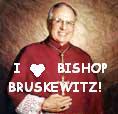Nebraska sent a Catholic bobsledder to the Olympics
Sacred Heart–Shelby parishioner pushes for Olympic victory
At the 2006 Winter Olympic Games in Torino, Italy, Shelby native and Sacred Heart parishioner Curtis Tomasevicz will be pushing the USA-II four-man bobsled down a twisting, turning track and — hopefully — winning a chance to stand on the podium and accept a medal.
The four-man bobsled competition is next Friday and Saturday, February 24 and 25. Curt may also compete in the two-man event this weekend, as the drivers are free to pick the teammate they feel will give them the best speed on the day of the run.
A former linebacker for the University of Nebraska-Lincoln (UNL) football team, Curt has been athletic all his life according to his mother, Amy Tomasevicz. “He was constantly in motion,” remembered Mrs. Tomasevicz, who also attends Sacred Heart, along with her husband Dennis, and teaches art at David City Aquinas.
After his career as a Husker walk-on was over, Curt entered the Master’s program in electrical engineering and continued to train in the UNL sports center. Two years ago, another former Husker athlete who was on the USA women’s bobsled team told Curt he’d make a great pusher – one of the guys who help the sled quickly get up to speed for the fastest possible score.
Curt was not only great, he was just about perfect. At 6’ 1” and 220 pounds, he said, “I'm right at the average size of a bobsledder.” His athleticism was a huge advantage, and he took to the sport rapidly, ousting several more experienced bobsled athletes for a spot on the national team.
“I believe that God gives everyone different gifts or potentials,” Curt offered. “It is what we do with those gifts that define how successful we are.”
One of the “gifts” in Curt’s life has been his hometown of Shelby, where locals staged several fundraisers, earning roughly $26,000 for his training and travels. “They’ve been terrific,” he said. “I couldn't have had the opportunity to be here without it.”
It’s an expensive sport, especially since there are only 16 bobsled tracks in the world, and the closest ones to Nebraska are in Lake Placid, New York, and Calgary, Canada. Curt divided his training time between those two sites and strength conditioning in San Diego, California.
“So far, the money Shelby earned has been able to cover everything,” a grateful Mrs. Tomasevicz said.
Training to push a bobsled is surprisingly similar to training for football. “Both require a lot of lifting and hard work,” Curt revealed.
The only trick was altering his running style. “As a football player, your muscles are tight because you could be hit at any time,” he explained. Running while pushing a bobsled requires a more relaxed gate.
Bobsledding might look like a fun, fast roller-coaster ride, but it is far more intense. And violent. As Curt described it, “Sometimes during the heavy curves, the G-forces will cause you to lose your breath.”
Plus, any time a person is hurtling at down an icy track at an average speed of 80 mph with minimal protection, there is a certain amount of danger. “I’ve been in two crashes in my brief career,” Curt said. Each time, the athletes could do nothing but continue sliding down the track upside down, helmets against the ice, waiting for the sled to stop.
That’s when Curt relied heavily on his Catholic upbringing. “It’s enough time to say three-and-half Hail Mary’s!” he reported.
Mrs. Tomasevicz thought she might let Curt give her a ride in a bobsled when she went to Calgary last year to watch him compete in the World Championships. “After seeing them do it once,” she confided, “I think I’ll just watch.”
Though Curt’s dad, Dennis, is unable to make the trip to Italy, his mom, brother and two aunts are all there to witness his Olympic debut. Although when it comes to bobsledding, spectators really don’t get to see much.
“You can kind of hear them coming and then, whoosh!” Mrs. Tomasevicz said.
As far as Curt’s medal potential, Mrs. Tomasevicz noted that his team has consistently placed in the top ten with every competition, often earning the fastest overall time on their second runs. “The first run is usually crummy,” she admitted, “but if they could get two good runs together, they could medal.”
Not that seeing her son win an Olympic medal of any color is crucial. “He’s having such a wonderful experience,” she said.
Curt and his teammates have every intention of putting themselves in medal contention, of course, even if it means upsetting the favored USA-I crew. Whatever happens, though he feels that he will come out on top. “I've met so many people, seen so many things and experienced so much,” he said. “Above all, I've learned a lot about myself.”
His free time is limited now that the Games have begun, but he managed to do a little sight-seeing after he got to Italy. He saw the Shroud of Turin with the team last week and said, “That was a very special moment for me.”
As he sat in the Olympic Athlete’s Village, he remembered what it was like to run into Memorial Stadium on game days. “I loved coming out of the tunnel…here was a huge sense of pride and honor wearing the N on my helmet.”
Now the uniform is blue instead of red (with a lot less padding) and his helmet reads USA. The feeling of honor and pride is even more pronounced. “Before we start at the line,” Curt said, “it gives me chills to hear the crowd chanting U-S-A, U-S-A…”
--Sparki

![[St. Mary's Messenger, A new Catholic magazine for children!]](http://stmarysmessenger.com/img/banners/stmarys-120x60.png)

0 Comments:
Post a Comment
<< Home